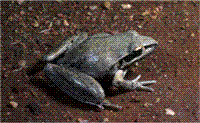Family
Hylidae
Genus
LitoriaSpecies
latopalmata
Threats/Control Methods - Regional
Broad-scale threatening includes habitat modification and urbanisation. Over grazing and trampling of native habitats by livestock may also be impacting on rural populations. L. latopalmata, like many other frog species, is thought to be vulnerable to the effects of Chytrid fungus. To prevent the spread of the Chytrid fungus it is important to wash your shoes before entering AND after leaving frog habitats. For more information on the Chytrid fungus see http://www.deh.gov.au/biodiversity/invasive/publications/c-disease/Local/Urban Actions
The construction of artificial water bodies may assist in the dispersal and breeding of the species. However, as the species does not require water outside of the breeding season, other habitat including rocks of varying size may help to provide refuge throughout the rest of the year. For more information on providing frog habitat in your backyard/schoolyard see Creating a Frog Friendly Habitat in the ACT Community.Distinguishing Features
Adults grow to around 3-4cm in length and range from pale grey to dark brown, sometimes with darker coloured blotches. A dark stripe runs from the pointed snout, through the eye and towards the flanks, where it starts to break up. A pale stripe also runs from under the eye to the base of the forearm. The backs of the thighs have a net-like brown and yellow pattern. The call resembles the quaking of a duck and is repeated rapidly. Tadpoles are a sandy gold colour with darker colouration near the base of the tail.
Common name/s
Broad-palmed Frog, Gravel Frog, Broad-palmed Rocket Frog, Gunther©s Frog.
Distribution
This species range extends through QLD, the North- East corner of South Australia, and the top half of NSW. Within the ACT it is most commonly found along sections of the Murrumbidgee river, and a few of the larger tributary streams between Kambah Pool and Lake Burrinjuck NSW.
Country of Origin
Australia
Survey Techniques
The most common technique for monitoring frog populations is based on call identification, with each frog species having a unique call.
Conservation (Pet/Pest) Status - National
Population thought to be stable or increasing
Conservation (Pet/Pest) Status - Regional
Thought to be stable.
LSCCES Population
Not common within the ACT, though not thought to be under threat. Not detected in the 2004 Frogwatch census.
Associated Vegetation Community
During the breeding season the species can be found near sources of still, flowing, natural or artificial sources of water, such as costal or river floodplains. Outside the breeding season Litoria latopalmata can be found in a variety of vegetation communities, not necessary those with water present, including forests and open country.
Breeding
Calls and breeds from September though to December. Clusters of eggs are found near the surface of the water and may be free floating or attached to vegetation.
Behaviour
During the breeding season males will call after rain. The species tends to move about living near water bodies during the breeding season, and migrating to other areas throughout the rest of the year.
Functional Group
Insectivore
Food Species
Small invertebrates such as beetles or moths.
Predators
May include native birds, such as the White-Faced Heron (Egretta novaehollandiae) and Intermediate Egret, and fish, including the introduced Carp, Goldfish and Trout. Introduced species such as Cats (Felis catus) and Foxes may also predate on frogs.
Interesting Fact
Frogs drink and breathe through their skin and are very sensitive to chemicals in their environment. Where possible, you should not handle frogs, as the natural bacteria on your hands or chemicals such as sunscreen can damage their skin and cause illness or death.
References - (reader suitability of references, P=Primary teachers, S=Secondary students, T=Tertiary students and researchers)
Books:
Barker, J., Grigg,G., Tyler, M. (1995). A Field Guide to Australian Frogs. Surry Beatty & Sons. NSW, Australia. S, TLintermans,M. & Osborne, W. (2002). Wet & Wild: A Field Guide to the Freshwater Animals of the Southern Tablelands and High Country of the ACT and NSW. Environment ACT. Canberra, Australia. S, TRobinson, M. (1993). A Field Guide to Frogs of Australia. Australian Museum/Reed books. NSW, Australia. S, TTurner, J. (2004). Frogs of Australia. Pensoft. Bulgaria. P, STyler, J. (1994). Australian Frogs: A Natural History. Reed New Holland. Australia. S, TSwan, G.(2001). Green Guide: Frogs of Australia. New Holland Publishers. Sydney, Australia. P, S
Online Publications:
Amphibian Research Centre. (2005) Available Online: http://frogs.org.au/frogs/species/Litoria/latopalmata/ S, TAustralian Frogs Database.(2005). Available Online: http://frogsaustralia.net.au/frogs/display.cfm?frog_id=160 S, TDepartment of Environment and Heritage, (2004) Chytridiomycosis Factsheet http://www.deh.gov.au/biodiversity/invasive/publications/c-disease/ S, TEnvironment ACT. (2004). Summary of results. Available online: http://www.environment.act.gov.au/Files/frogwatchoctober2004summary.pdf P, S, TZoological Parks and Gardens Board. Frog Pond Checklist. Available Online: http://www.zoo.org.au/education/factsheets/amp-frog_pond_checklist.pdf P, S, TSpeare, R et al (1998). HOW TO REDUCE THE RISKS OF YOU TRANSMITTING AN INFECTIOUS AGENT BETWEEN FROGS AND BETWEEN SITES. Available Online: http://www.jcu.edu.au/school/phtm/PHTM/frogs/prevent.htm S, TZoological Parks Board N>S>W. (2005.). ASX Frog Focus. Available online: http://www.asxfrogfocus.com/ P, S (School activity program)
Researcher: Pippa Jaminon

 Top
Top Top
Top